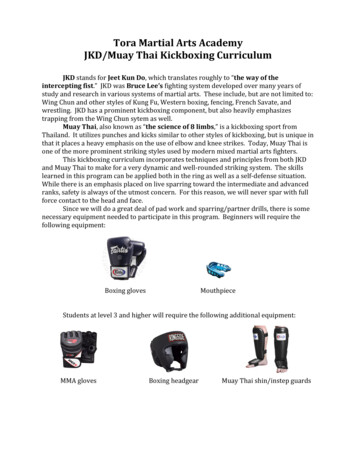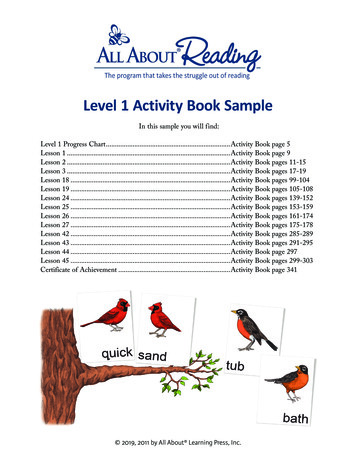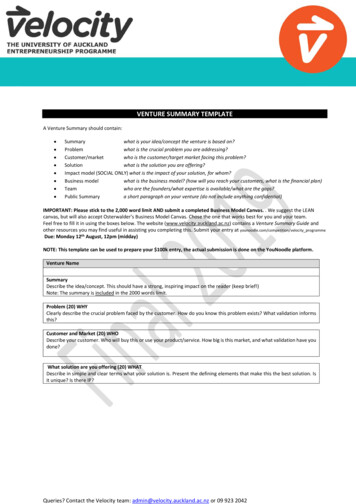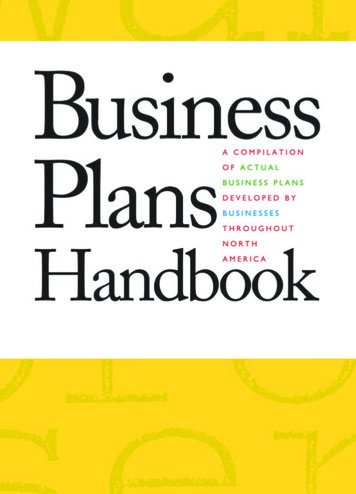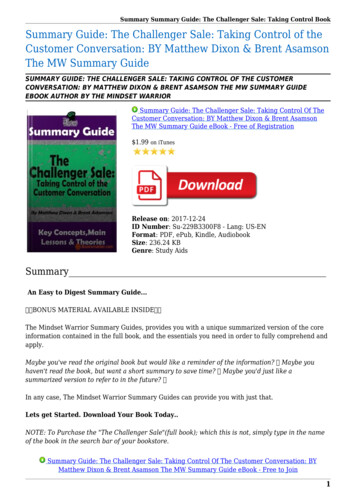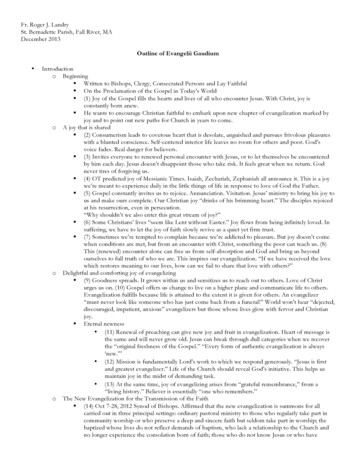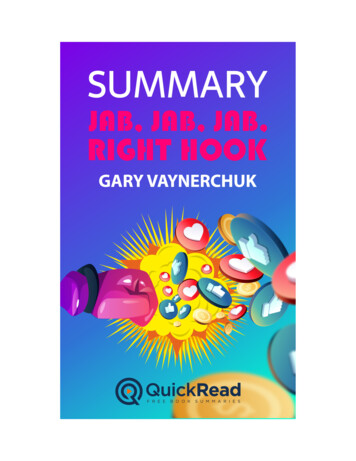
Transcription
Summary of “Jab, Jab, Jab,Right Hook” by GaryVaynerchukWritten by Alyssa BurnetteHow to pack a powerful punch on social media.
Introduction5How to Make Social Media Work For You6How to Win at Facebook8Why Pinterest is the Best Kept Secret of Marketing10Tweet About It12Final Summary13
IntroductionHave you ever scrolled through your Facebook feed and wondered, “Whyon earth would someone post that?” or “Do they really think anybodycares?” We’ve all been there, right? Because people post about everythingfrom their baby’s potty-training progress to what kind of sandwich they are(according to a personality quiz)! As a result, it often feels as though theinternet is just a void for lots of idiots to scream into publicly. And withall that social media clutter, it’s unsurprising that you might find yourselfasking, “How do I make people listen to what I have to say?” or “How can Ibe sure my posts aren’t annoying?” Well, over the course of this summary,we’re going to answer both of those questions and more.
How to Make Social Media Work For YouSo, we already know that you can’t run a successful marketing campaignwithout social media. Before we dive into any other information, we have toaccept that as a baseline fact. Gone are the days of old-school print mediaand the campaigns that were based on the simple distribution of flyers.Today, you have to have a social media presence if you want to attractcustomers. But how do you craft a campaign that really works? And how doyou get people to listen in the first place? The author observes that if youreally want to win at social media, you need to tell a story. And whetheryou’re trying to market yourself or your brand, this strategy remains true.Because anybody can scream into the void or engage in contests todetermine who can scream the loudest. And because customers realize that,they can just as easily mute you by unfollowing, deleting, or scrolling pastyour content. Put simply, it doesn’t matter how loud you scream or howmany ad campaigns you launch; if people aren’t interested, they can stillfind ways to avoid you.But if your brand tells a story, people want to engage. While that story willobviously look different for everyone, the author observes that manysuccessful marketing campaigns are customer directed in that they inviteindividual customers to tell their own stories through the form of an adcampaign. For example, if you’re trying to sell FitBits, you could encouragecustomers to post on their own social media channels about theirexperience with FitBits. Ask them to talk about their relationship withexercise and how their FitBit is part of that story. Invite them to postpictures of themselves exercising with the promise of the best snaps gettingfeatured on your account. This engaging narrative-- combined with thehope of having their picture displayed in front of millions-- will get peopleexcited in a hurry!But creating quality content is only the first step. You also have to thinkabout how-- and where-- that content is going to be displayed. For example,ad campaigns that look too gimmick-y fall right into the “screaming into the
void” category. People are tired of seeing those and they’ve learned to muteor follow them. As a result, your goal should be to create content thatdoesn’t look like an ad. Instead of bright, flashy graphics and clickbait-yheadlines, go for a high quality post that looks like it naturally belongs onan aesthetically pleasing feed. Whether that means partnering with leadingmodels and influencers who can showcase your brand or designingsomething entirely new, your goal is to create an image so compelling thatpeople are drawn to hit “like” and check it out. When they see your image,they should be so surprised that they exclaim, “That’s an ad?”But it’s also important to consider where you post your ads. For example, ifTwitter isn’t the hot thing at the moment, you probably shouldn’t wastetime posting there. Similarly, if you post on a buzzing social network butfail to follow the etiquette of that platform, you’re shooting yourself in thefoot. So, take some time, do your research, and craft a meaningfulcampaign that tells a story.
How to Win at FacebookBut now that we’ve covered the social media basics, let’s take a closer lookat a few specific platforms. We’ll start with Facebook. Although manyyounger users turned to alternative platforms like Tumblr or Instagramwhen their parents got on Facebook, the truth is that pretty mucheverybody is still on Facebook. This means that advertising on Facebookcan give you the opportunity to put your product in front of your millions ofpeople around the world! Its interactive nature also means that users canspread your ad to one another like a virus, increasing your exposure. And asanother added bonus, Facebook is also less expensive than other forms ofmass advertising, such as putting your ad on a billboard or a commercial.So, to recap, Facebook allows you to advertise to the entire world for afraction of the price! Sounds fantastic, right? Except it’s not that easy.That’s because Facebook-- believe it or not!-- carefully curates itsalgorithms to ensure a positive user experience. And as a general rule, thatmeans limiting the authority and prevalence of ads.So, what does that mean for you as an advertiser? Well, for starters, itmeans that if you want to put your ad on Facebook, your content has to beawesome. As we discussed in the previous chapter, curating quality contentis everything. But it takes on a new significance when you’re talking aboutadvertising on Facebook. Because Facebook literally filters its news feed toscreen ads and allows users to opt out of ads that are irrelevant or annoyingto them, you should only attempt to advertise on Facebook if you’re certainthat your content won’t be flagged by the majority of its users. However,that’s not the only issue to consider. Facebook’s algorithm is also highlyselective in the content it displays to users. It uses a person’s previousactivity on the site to create a profile of their interests and filter the contentthey see accordingly.For example, if you frequently “like” a lot of cat memes, Facebook is goingto recommend a lot of cat memes and allow similar posts to frequently popup on your feed. So, if you want your post to get a lot of likes, you need to
carefully research your demographic and ensure that you’ve createdsomething they’ll interact with. Because unless it draws a lot of likes andcomments, it won’t matter how much you’ve paid for your ad; in the end, itwill all be for nothing!
Why Pinterest is the Best Kept Secret of MarketingAre you a Pinterest user? If not, you’re not alone; many people preferInstagram or Facebook and view Pinterest as more of an obscure networkfor people who enjoy crafts. But that’s actually something of a commonmisconception and it belies the hidden power of Pinterest: it’s primarilyused by women and it’s not just for people who like crafts. (It might interestyou to know that, in contrast to the diverse demographics demonstrated onother platforms like Facebook and Instagram, over 75% of Pinterest usersare female and 50% of them are mothers!) So, how does Pinterest workexactly? Well, for starters, it’s a space for users to “pin” posts about avariety of interests and create collages of things they like. And although itmay be primarily used by women who enjoy crafts, it also attracts womenwho have a host of other interests and use Pinterest as a platform toconnect with one another.This means that advertising on Pinterest is a relatively untapped marketer’sdream that will put your product in front of millions of people! Advertisingon Pinterest is also more likely to generate sales revenue than advertisingon other platforms. And, as the author observes, there are a host ofstatistics to back it up! For example, a 2012 survey of advertisers discoveredthat 79% of their sales had come from people who bought their product onPinterest. Their sales on Facebook paled in comparison. So, in light of this,we can conclude that Pinterest is not only the way to go, but that it’s alsoincredibly helpful if you intend to market to women.Misconceptions about the popularity and function of Pinterest have ledmany advertisers to ignore it as a resource, but those misconceptions arethe only thing holding you back! So, now that you know, you can get aheadof the game! As you dive into Pinterest, however, remember that everyplatform has its own standards of etiquette. Pinterest is somewhat similarto Instagram in that its content is comprised primarily of compellingpictures. So, a good rule of thumb would be to concentrate on creatingaesthetically pleasing pictures that you can post on multiple platforms. And
because Pinterest is so diverse, it might be worth promoting your content ina variety of different ways so you can end up on “pin boards” for a diversecollective of users.For example, let’s say you’re trying to sell customized, stylish bandanas forwomen and their cats. For one post, you might try a photo of a model andher cat wearing a matching set. For another, you might simply post a cutepicture of a cat (aimed at cat lovers) or a funny cat meme (aimed at userswho frequently like posts about cats and humor). Likewise, additional postscould target users who are interested in fashion, social media marketing,animal shelters, crafts, or photography!
Tweet About ItAnd last but not least, we come to Twitter. Unlike Facebook and Instagram(which everybody uses) and Pinterest (which people assume no one uses),Twitter is something of a middle ground. Some people hate it and somelove people love it, but you can’t deny its statistics; Twitter boasts anaverage of 1.3 billion users! However, this overwhelming population is botha blessing and a curse. On one hand, Twitter’s user base presents anincredible amount of potential customers. Unfortunately, however, thatalso means that if you want to stand out, you have to make yourself heardover 1.3 billion voices. Unsurprisingly, when you think about it that way,the prospect of advertising on Twitter is both less exciting and moreconcerning than advertising on Facebook, Pinterest, or Instagram. So, howcan you make yourself stand out on Twitter?The author recommends a strategy called “trendjacking.” Put simply,“trendjacking” involves capitalizing on the topics that are currentlytrending by finding a way to insert yourself and your content into the mix.For example, that might mean that you write a post or organize a charityevent to help with a certain social issue. Or, for causes that aren’t serious orsignificant, it might mean that you add a trending hashtag to your post todraw traffic to your site. Hashtags can be extremely useful because theyprovide a means of filtering the most popular topics and searches thatpeople are talking about at the moment. You can use hashtags to drawattention to an issue, contribute to the conversation, or direct people toyour posts. This, of course, makes them a very popular feature; manybusinesses even incorporate hashtags into their brand names or marketingcampaigns in an attempt to appear hip and socially relevant. However, thisoften leads to a behavior that is commonly termed “hashtag abuse,” and ifyou misuse hashtags, it can backfire quickly. Rather than demonstratingthat you’re relevant and trendy, you might accidentally communicate thatyou’re clueless and wrong.
Final SummaryEveryone wants to win at social media, especially when you’re running abusiness. But the overwhelming vastness and popularity of social mediaalso means that it’s easy to get lost in the crowd or unknowingly commit asocial media faux pas. That’s why the author advises that you take sometime to research the various platforms available, along with theirdemographics and particular brand of etiquette, to identify the options thatare most accessible for you. Once you’ve narrowed down your options, youcan follow the author’s top tips to cultivate a knockout social mediacampaign.
Summary of “Jab, Jab, Jab, Right Hook” by Gary Vaynerchuk Written by Alyssa Burnette How to pack a powerful punch on social media. Introduction 5 How to Make Social Media Work For You 6 How to Win at Facebook 8 Why Pinterest
